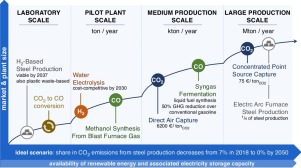Current Opinion in Chemical Engineering ( IF 8.0 ) Pub Date : 2019-10-25 , DOI: 10.1016/j.coche.2019.09.001 Kevin De Ras , Ruben Van de Vijver , Vladimir V Galvita , Guy B Marin , Kevin M Van Geem

|
The availability of green electricity, changes to the Emission Trading Scheme (ETS) system and technological breakthroughs will determine how the steel industry will evolve in the coming decades. The blast furnace (BF) technology will continue to dominate steel production in the coming decade and the only way to substantially reduce the associated CO2 emissions is to combine it with Carbon Capture and Utilization (CCU) and/or Carbon Capture and Storage (CCS). CCU options that do not require a lot of hydrogen and with high added value are logical step stones towards production of bulk chemicals and even fuels such as oxymethylene ethers. BF waste gas recycling and conversion will require a multisectoral approach creating new dependencies between the steel, energy, and chemical sectors. Energy efficient, cheap and CO2 free hydrogen production using green electricity is the ultimate solution to drive this transition. This hydrogen could on the long term also open the door to replace blast furnaces by hydrogen-based steel making. However, today it makes economically more sense to use thermally produced hydrogen by (bio)methane pyrolysis or steam reforming, potentially electrified and intensified, rather than from water electrolysis. Having novel and existing elements from the chemical engineers' toolbox such as artificial intelligence, catalysis and reaction engineering, process intensification principles and multiscale modeling and design, should bring these emerging technologies within reach by the end of the next decade.
中文翻译:

钢铁行业的碳捕集与利用:化学工程的挑战与机遇
绿色电力的可用性,排放交易计划(ETS)系统的变化以及技术突破将决定钢铁行业在未来几十年的发展方式。高炉(BF)技术将在未来十年继续主导钢铁生产,这是大幅减少相关CO 2的唯一方法排放是将其与碳捕集与利用(CCU)和/或碳捕集与封存(CCS)结合使用。不需要大量氢气且具有高附加值的CCU选件是生产散装化学品甚至燃料(例如甲醛醚)的逻辑步骤。高炉废气的再循环和转化将需要采用多部门方法,从而在钢铁,能源和化学部门之间建立新的依存关系。节能,便宜和CO 2使用绿色电力免费生产氢气是推动这一转变的最终解决方案。从长远来看,这种氢气还可以为氢基炼钢取代高炉打开大门。但是,今天,通过(生物)甲烷热解或蒸汽重整使用潜在产生的电和强化的热产生的氢气,而不是水电解,在经济上更有意义。化学工程师工具箱中具有新颖和现有的元素,例如人工智能,催化和反应工程,工艺强化原理以及多尺度建模和设计,这些新兴技术应在下一个十年末实现。











































 京公网安备 11010802027423号
京公网安备 11010802027423号